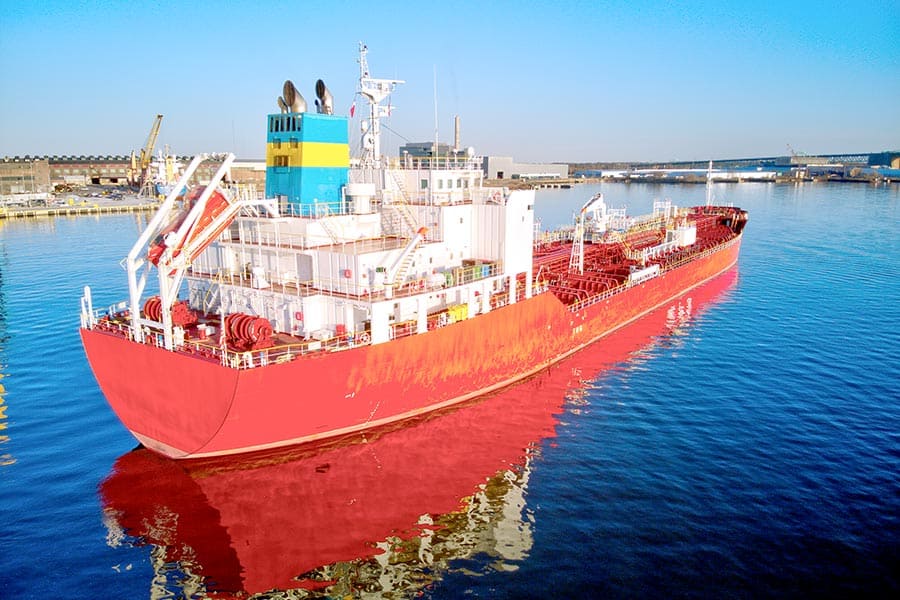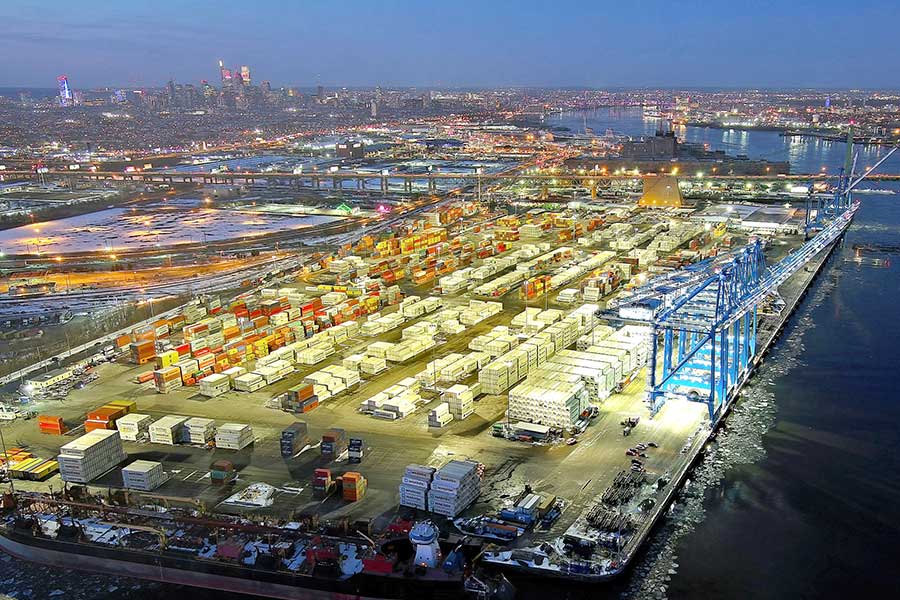
Philadelphia, renowned as a center of commerce and industry, is one of the most significant cities in the United States. But is Philadelphia a port city?
Philadelphia is a vital port city. While it is not the largest seaport in America, it is one of the busiest and fastest-growing seaports. The port at Philadelphia adds billions of dollars of value to the economy and facilitates the import and export of millions of tons of freight.
How deep is the Port of Philadelphia? Who owns the port? Why is it such a busy seaport? There’s much to learn about the Port of Philadelphia, so continue reading.
The Philadelphia Seaport
The Port of Philadelphia was established around the year 1701. As Pennsylvania and the United States have grown over the intervening 300 or so years, the port has remained one of America’s critical shipping ports, a place where coal, timber, ore, steel, and other resources are shipped out, and fruit, meat, pulp, fuel, and other essentials are shipped in. Today, the Port of Philadelphia – also known as PhilaPort – handles more than 7 million tons of cargo every year, making it a very busy seaport by any measure.
PhilaPort sits at the junction of the Delaware and the Schuylkill Rivers. From there, it’s a relatively short trip down the Delaware River to Delaware Bay and, eventually, the Atlantic Ocean. From the Atlantic, vessels sail literally all over the world: a typical day at PhilaPort might see a ship from Scandinavia, one from China, another from South America, and perhaps a few from Europe or even Africa.
In fact, the Port of Philadelphia handles a diverse array of cargo, with millions of shipping containers full of assorted freight passing through the port annually. The port handles automobiles, bulk food products like soybeans, ethanol, industrial chemicals, and forest products like paper and pulp. Most notably, Philadelphia is a huge entry point for cocoa beans, which are subsequently shipped to prominent chocolate manufacturers.

PhilaPort is an enormous facility. In total, the port covers more than 1,000 acres of riverfront land that includes easy access to rail yards and trucking terminals to distribute the freight from the port to the rest of the nation. Some of the different facilities at PhilaPort include:
- Tioga Marine Terminal, which handles containerized and bulk cargo, including steel, forest products, and palletized freight;
- Tioga Liquid Bulk Terminal, which handles things like petroleum or bulk liquid chemicals;
- Piers 74, 78, and 80, which handle forest products such as paper, pulp, wood, and wood derivatives;
- Pier 82, which handles fruits, vegetables, and dry bulk freight like soybeans or corn;
- Pier 84, which imports huge quantities of cocoa beans and offers grading and sorting services;
- The Packer Avenue Marine Terminal, which handles container ships and containerized freight;
- The Pier 98 Annex Auto Facility and Pier 122, which process roll-on/roll-off cargo such as motor vehicles and offer a direct connection to Norfolk Southern and CSX rail lines;
- Pier 124, which handles liquid bulk cargo such as ethanol; and
- Piers 96, 98, and 100, which are (as of 2022) being developed for future use.
For a time, Philadelphia was a cruise-ship destination. The Philadelphia Cruise Terminal opened in 1998 and began servicing vessels from a variety of cruise lines. However, by 2011, the number of cruises to and from Philadelphia had dwindled significantly. It takes about six hours to get from Philadelphia to the open ocean, and the river can be challenging to navigate. That, plus the general economic conditions of the early ’10s, caused the cruise terminal to shut down.
How Deep is the Port of Philadelphia?
The Port of Philadelphia is 45 feet deep. To put that in perspective, the Port of New York is 50 feet deep, and Port Miami is 43 feet deep. In a bold move, Port Charleston is deepening from 45 to 52 feet, making it the deepest seaport on the East Coast. Regardless, the port of Philadelphia is one of the deeper ports on the Eastern seaboard.
If you’re more of a visual person, picture it this way: the Port of Philadelphia is just deep enough to submerge the average three-story building. In the parlance of the internet, you could also say that the port is 108 hamburgers deep, or 7.3 Range Rovers in depth.

So what size of ships can come into the Port of Philadelphia? The largest vessel to visit the port so far is the 1,100-foot-long M/V MSC Shuba B, which can carry roughly 12,200 20-foot cargo containers. On her 2018 visit, Shuba B brought a massive shipment of fruit from Chile and Peru that included pears, blueberries, plums, grapes, and peaches.
Who Owns the Philadelphia Port?
The Philadelphia Port is owned and operated by the Philadelphia Regional Port Authority, also known as PhilaPort. However, PhilaPort is actually an independent agency of the State of Pennsylvania. In other words, the port is effectively owned by the people of the State of Pennsylvania.
Keystone Answers Fun Fact: From 1790 to 1800, Philadelphia was actually the nation’s capital city.
The actual operations at the port are conducted by independent commercial agencies. In other words, the state owns the port, but all of the actual work conducted there is performed by businesses that are paid by the state. A wide variety of companies offer services such as ground transportation, fuel, warehousing, and marine maintenance at the port.
Why Did Philadelphia Become a Busy Port?
Philadelphia’s port became very busy for two main reasons: location and history. First, the location of the seaport at the intersection of the Delaware River and the Schuylkill River connected Philadelphia and interior Pennsylvania to international shipping via the Atlantic Ocean.
The Delaware River begins in the Catskills and runs all the way to the Atlantic Ocean. Most of the river is not navigable to large vessels, but the section that runs from the ocean to Philadelphia is able to accommodate large cargo vessels. It is the Delaware River that connects Philadelphia to the Atlantic Ocean and the rest of the world.

Though it is less important to commerce today, when Philadelphia was first founded, the Schuylkill River was a vitally important trade route. The Schuylkill runs about 135 miles and connects Philadelphia with interior Pennsylvania. In the days before rail, trucking, and air freight, the river was the most efficient way to ship goods to and from interior Pennsylvania.
The Schuylkill became especially important as the Industrial Revolution took hold. The river connects Pennsylvania’s coal country to Philadelphia, and as the demand for coal surged, it became a vital shipping route to move this essential fuel to the furnaces of Philadelphia’s iron and steel plants.
Historically, Philadelphia has always been a vitally important city. Even a few short years after its founding, the city had exploded in population as immigrants from England, Ireland, Scotland, and Germany flooded into Philadelphia in search of religious tolerance and participatory government. By the 1770s, more than 30,000 people lived in Philadelphia.
This booming population led to a strong commercial and industrial presence in the city. Textile and tool manufacturing, iron and steel making, warehousing, and other industries soon found Philadelphia – and its seaport – to be the ideal place to set up shop.

Is the Port of Philadelphia the Biggest East Coast Port?
The Port of Philadelphia is a large and vital seaport. It was the largest seaport in the United States until 1810, when New York’s port surpassed it in size and volume. The Port of New York and New Jersey remains the largest port on the East coast to this day. Regardless, the Port of Philadelphia is still a critical part of America’s trade infrastructure.
Indeed, the Port of Philadelphia is the largest refrigerated port in the United States. It is estimated that the port adds more than $30 billion in trade value to the economy every year, and about 55,000 people work at the port, making it a critical asset to the economy of both Pennsylvania and the United States.
Luckily, the boom times for PhilaPort are likely to continue. The port is often said to be the fastest-growing seaport in the US and has seen massive growth over the last several years. Between 2017 and 2021, the port saw a 10% increase in tonnage, recording about 7 million tons of cargo in 2021. That’s about 14 billion pounds of freight!
Philadelphia: One of America’s Best Ports
Philadelphia is one of America’s most historically significant and important cities, and its seaport is equally notable. Founded way back in 1701, the port has been part of America’s fabric since our nation’s very beginning. The port employs tens of thousands of Pennsylvanians and facilitates the shipment of millions of tons of goods every year. As a result, the port at Philadelphia is a critical and essential part of the American economy, and while Philadelphia is many things to many people, it remains a port city to this day.






